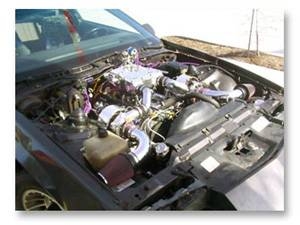
For every do-it-yourself upgrade a car owner installs, some pride comes from having well-maintained performance equipment and the added horsepower. Performance achieved after an upgrade job is completed on an automatic car can be impressive. With new upgrades to the air intake, exhaust, computer and transmission, a stock vehicle could achieve the same level of performance as competitive race cars running in a semipro-class event. Follow this order of installation to get the best results from an automatic car after you do performance work to make it go faster.
Remove the stock air box and filter using a screwdriver, a wrench and a utility knife. Remove the tube connecting the air box to the air intake manifold. Cut the rubber elbow away from the intake sleeve if it will not come off easily. Unbolt the air box from its mounting bracket and discard the entire stock air box and tube. Install a new air intake tub and high-flow air filter that will push cool, dense air into the intake for more power. Secure the new air intake and filter to an existing anchor point using the brackets that come with the kit.
Raise the car high enough to access the catalytic converters in the exhaust tubing of the vehicle. Located near or under the passenger compartment, the converters look like mini mufflers in a bad spot. Mark the exhaust pipes 3 to 4 inches away from the inlet and outlet of the converter and cut the converter out with a reciprocating saw. Measure the new high-flow catalytic converters in length to be sure you cut enough, but not too much, exhaust pipe out with the old converter. Slide the converter into place and secure with exhaust clamps made to tighten overlapping pipes together.
Plug the electronic performance programmer into the vehicle's computer adapter (the same adapter used to diagnose engine problems). Stock computer programs for electronically-driven car models include the high-end programming that comes inside automatic transmission models direct from the manufacturer. Answer the yes or no questions asked by the performance programmer to install the upgrade. A new performance program will produce more power and can make an automatic car go faster by changing the way the engine responds to the different sensors that keep the engine running as designed.
Even the most well-designed vehicle can lack a performance transmission shift kit that tells the vehicle how to perform better. Engineers from the factory look for the most efficient use of the car components that fit within the limits of reliable transportation. Drop the transmission pan and remove the throttle body that sits just beneath it. The transmission fluid filter and gasket should be replaced before securing the pan back on. Complete the shift kit by replacing the ball valves that make the transmission shift more aggressively, then close it all back up and refill the transmission with fluid while the car is running.
Once the car has been restarted, inspect all the connectors and fasteners during the fluid replacement portion of this project. With the car warm, retighten all the nuts and bolts you loosened in this project. The integrity of these connections will be key in the reliability of each part. The exhaust connection, intake hoses and transmission pan bolts should all be tightened with the proper torque limits and prepared for the driving conditions expected once the upgrades are complete.